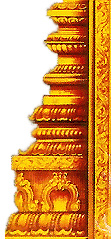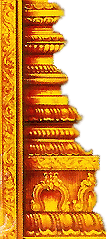|
|
Home >>
Other Temples >
sri Aiyanarswami temple
|
| |
- Details
- Path
- Map
- Photos
- Near By Temple
| |
| |
|
![[Image1]](http://img1.dinamalar.com/Kovilimages/T_500_715.jpg)
|
| | |
| | | |
|
|
|
Moolavar | : |
Aiyanar |
|
|
Urchavar | : |
- | |
|
Amman / Thayar | : |
- | |
|
Thala Virutcham | : |
Tamarind tree | |
|
Theertham | : |
Vaigai, Azhagar temple theertham | |
|
Agamam / Pooja | : |
- | |
|
Old year | : |
1000-2000 years old | |
|
Historical Name | : |
- | |
|
City | : |
Kochadai | |
|
District | : |
Madurai
| |
|
State | : |
Tamil Nadu |
| |
|
|
| |
|
|
 | Singers: |  |
| |
|
|
| |
- |
|
| |
|
|
 |
Festival: |
 |
| |
|
|
| |
Mahashivarthri is celebrated for three days in the month of Masi, February-March. The other festival in Purattasi (September-October) is celebrated only by the villagers of Kochadai on getting the permission from a lizard sound from a plam tree in the month. If the approval is not obtained, the festival would be postponed to the next year, according to the priest of the temple Muthu Venkatachalam. The tradition is followed even now.
The Soolattu Puja festival for Rakkayi Amman and the Pavadai puja festival for Muthiahswami by the family trustees are very famous for all their pomp and splendour. This is a Murayeedu (submission) temple. |
|
| |
|
|
 |
Temple's Speciality: |
 |
| |
|
|
| |
The antiquity of the temple and its tamarind tree date back over 2000 years. |
|
| |
|
|
 |
Opening Time: |  |
| | | | | |
The temple is opened from 11.00 a.m. to 1.00. and 4.00 p.m. to 9.00 p.m. |
|
| | | |
 |
Address: |  |
| | | | | |
Sri Aiyanarswami Temple, Kochadai, Madurai. |
|
| | | |
 |
Phone: |  |
| | | |
| |
+91 452 6524201 | |
|
| | |
 |
General Information: |  |
| |
|
|
| |
There 21 deities in the temple, Aiyanar with a bow, Muthiahswami, Karuppuswami, Agni Veerabadrar, Karuppayi Amman, Sangilikaruppu, Kaluvadikaruppu, Meiyandi Amman, Nagappaswami, Sannasi, Aadipoosari, Pechiamman, Muthukaruppuswami, Irulappaswami, Veeranaswami, Rakkayi Amman, Irylayee Amman, Chappani, Sonai Muniyandi and Badrakali. Karuppuswami and Muthiah shrines are at the right and Nagappaswami on the left of Aiyanar. People of all communities worship Aiyanar as their Kuladevatha. As Aiyanar is very powerful, as a courtesy, no horse or carts drawn by horses would not cross this area. There are statues for the three Tamil kings, Chera, Chola and Pandya and idols for Saptha Kannis the seven maidens. |
|
| |
|
|
 |
Prayers |  | |
|
| | | |
For removal of Naga Dosha, devotees pour milk to Nagamma under the tamarind tree. Those seeking wedding boon tie Mangal Sutras and those seeking child boon tie crades with Saris in the tree. | | |
|
| |  |
Thanks giving: |  | |
|
| | | |
Devotees pour milk to Nagamma on realizing their wishes. | | | |
| |  |
Greatness Of Temple: |  |
| |
|
|
| |
The devotee is greeted with Villayudham Udaya Aiyanar (Aiyanar with a bow) on a horse and Muthia with the pancha bhoodas. Next is seated the white elephant gifted to Aiyanar by Indira. Aiyanar graces in the sanctum sanctorum with His consorts Pooranai and Pushkala. Shenbagavalli Aiyanar with Pooranai and Pushkalai discovered in the Shenbaga garden of king Shenbaga Pandian also graces near the sanctum. The white elephant and the horse are His vahans-vehicles.
This is an ancient temple belonging to the Pandia period. Aiyanar is a guardian deity of Madurai border. A horse and Bhooda-also a guardian deity-were the first built by Tirumalai Naicker. In the earlier days, one Muthiahswami came to Aiyanar seeking asylum and as He became popular, the temple came to be known as Muthiah Koil. Indira, the king of Devas entrusted Lord Aiyappa’s upbringing to one Kulala. They also installed Aiyanar as the guardian deity at all bornder places. Acknowledging their Pujas, Aiyanar is gracing the people.
The Tamarind tree is described in Tamil as Puli Aayiram, Pondu Aayiram meaning that there would be thousands of holes in the tree. The tree is very ancient ageing 2000 years. It is believed that Sage Patanjali performed penance here. The tree is worshipped by devotees for removal of Nagadoshas – adverse snake aspects, for wedding boon and for child boon. It is surprising that even when some long and strong branches of the tree fell down due to ageing, no damage was caused to the temple. |
|
| |
|
|
 |
Temple History: |  |
| |
|
|
| |
The epic speaking the 64 blessingful events of Lord Shiva has a mention about Kochadai. With a view to take an old lady Vandhi by name, Lord Shiva caused heavy floods in River Vaigai. While one in each family was demanded to repair the breaches caused by the flood, as Vandhi had no one to offer for the job, Lord Shiva Himself came to her rescue offering Himself for the job taking the pudding Vandhi was selling for his wage. King Pandya, dissatisfied with His work caned Him in anger – Kovichu Adi – in Tamil. The place also came to be known as Kovichu Adi which in course of time changed to Kochadai. There is a Chokkanatha temple near this place. It is said that this is the original place from where Mother Meenakshi graced devotees. |
|
| |
|
|
 |
Special Features: |  |
| |
|
|
| |
|
|
| |
|
|
|
| |
|
|
|
|
| | Location :
The temple is 3 km west of Madurai central bus stand.
Near By Railway Station :
Madurai
Near By Airport :
Madurai
Accomodation :
Madurai:
Pandian Hotel: +91-452-435 6789
Hotel Sangam: +91-452-253 7531, 424 4555
Hotel Tamilnadu: +91-452 253 7461 (5 lines)
Hotel Supreme: +91-452-234 3151,301 2222
Hotel Premnivas: +91-452- 234 2532-3. 437 8787
Hotel Park Plaza: +91-452-301 1111, 234 2112
Hotel Northgate: +91-452-438 3030 (4 lines, 252 3030 (4 lines)
Hotel Keerthi: +91-437 7788, 437 8899
Hotel Golden Park: +91-452 235 0863
Hotel Ratna Residency: +91-452 437 0441-2, 437 4444
| |
| |
|
|
![[Gal1]](http://img1.dinamalar.com/KovilImages/GalleryThumb/G_T7_715.jpg)
|
|
 |
| பூரண புஷ்கலாவுடன் அய்யனார் |
|
|
|
|
 |
|
|
|
|
|





